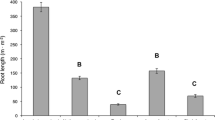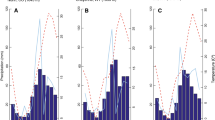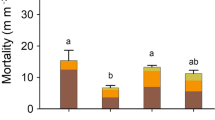Abstract
Although root growth and mortality play critical regulatory roles in terrestrial ecosystems, little is known about the temporal scale of these dynamics. In temperate grasslands, root dynamics may be particularly rapid because of the high proportion of production allocated to very fine root biomass. In this study, we used minirhizotron tubes to estimate root growth and mortality in an upland grassland in Yellowstone National Park that was grazed by migratory herds of ungulates. Monthly rates of root growth and mortality were estimated from May to September 2005, by measuring the elongation (growth) and disappearance (mortality) of roots at 3-day intervals. Average daily growth (millimeters of root length) was approximately 5 times greater in May and June than in July, August, and September. Average daily mortality (millimeters of root length) did not differ among months. A comparison of the June–September rates of root growth and mortality derived from sampling at short (3-day) and long (1-month) time intervals indicated that the long sampling intervals underestimated both growth and mortality by approximately 60% relative to the short intervals. These results suggest that estimates of grassland root dynamics from minirhizotrons are influenced significantly by sampling interval length, and that rapid root turnover may play a more critical role in regulating energy and nutrient fluxes in temperate grasslands than has previously been recognized.


Similar content being viewed by others
References
Aerts R, Berendse F, Klerk NM, Bakker C (1989) Root production and root turnover in two dominant species of wet heathlands. Oecologia 81:374–378
Arnone JAIII, Zaller JG, Spehn EM, Niklaus PA, Wells CE, Körner C (2000) Dynamics of root systems in native grasslands: effects of elevated atmospheric CO2. New Phytol 147:73–85
Eissenstat DM, Yanai RB (1997) The ecology of root lifespan. Adv Ecol Res 27:1–60
Eissenstat DM, Wells CE, Yanai RD (2000) Building roots in a changing environment: implications for root longevity. New Phytol 147:33–42
Frank DA, McNaughton SJ (1992) The ecology of plants, large mammalian herbivores, and drought in Yellowstone National Park. Ecology 73:2043–2058
Frank DA, Kuns MM, Guido DR (2002) Consumer control of grassland plant production. Ecology 83:602–606
Frank DA (2007) Drought effects on aboveground and belowground production in a temperate grazed grassland ecosystem. Oecologia 152:131–139
Gill RA, Jackson RB (2000) Global patterns of root turnover for terrestrial ecosystems. New Phytol 147:13–31
Hendrick RL, Pregitzer KS (1992) The demography of fine roots in a northern hardwood forest. Ecology 73:1094–1104
Hendrick RL, Pregitzer KS (1993) Patterns of fine root mortality in two sugar maple forests. Nature 361:59–61
Hendrick RL, Pregitzer KS (1996a) Applications of minirhizotrons to understand root function in forests and other natural ecosystems. Plant Soil 185:293–304
Hendrick RL, Pregitzer KS (1996b) Temporal and depth-related patterns of fine root dynamics in northern hardwood forests. J Ecol 84:167–176
Higgins PA, Jackson RB, Des Rosiers JM, Field CB (2002) Root production and demography in a California annual grassland under elevated atmospheric carbon dioxide. Global Change Biol 8:841–850
Houston DB (1982) The northern Yellowstone elk: ecology and management. Macmillan, New York
Jackson RB, Mooney HA, Schulze ED (1997) A global budget for fine root biomass, surface area, and nutrient contents. Proc Natl Acad Sci USA 94:7362–7366
Johnson MG, Tingey DT, Phillips DL, Storm MJ (2001) Advancing fine root research with minirhizotrons. Environ Exp Bot 45:263–289
Katterer T, Fabiao A, Madeira M, Ribeiro C, Steen E (1995) Fine-root dynamics, soil moisture, and soil carbon content in a Eucalyptus globulus plantation under different irrigation and fertilization regimes. For Ecol Manage 74:1–12
Lauenroth WK, Gill (2003) Turnover of root systems. In: de Kroon H, Visser EJW (eds) Root ecology. Springer, New York, pp 61–89
McClaugherty CA, Aber JD, Melillo JM (1982) The role of fine roots in the organic matter and nitrogen budgets of two forested ecosystems. Ecology 63:1481–1490
McNaughton SJ (1985) Ecology of a grazing ecosystem: the Serengeti. Ecol Monogr 55:259–294
Meagher MM (1973) The bison of Yellowstone National Park. National Park Service scientific monograph series number 1. United States Department of Interior, Washington
Merrill EH, Stanton NL, Hak JC (1994) Response of bluebunch wheatgrass, Idaho fescue, and nematodes to ungulate grazing in Yellowstone National Park. Oikos 69:231–240
Milchunas DG, Lauenroth WK (2001) Belowground primary production by carbon isotope decay and long-term root biomass dynamics. Ecosystems 4:139–150
Milchunas DG, Morgan JA, Mosier AR, Lecain DR (2005) Root dynamics and demography in shortgrass steppe under elevated CO2, and comments on minirhizotron methodology. Global Change Biol 11:1837–1855
Nadelhoffer KJ, Raich JW (1992) Fine root production estimates and belowground carbon allocation in forest ecosystems. Ecology 73:1139–1147
Ruess RW, Hendrick RL, Bryant JP (1998) Regulation of fine root dynamics by mammalian browsers in early successional Alaskan taiga forests. Ecology 79:2706–2720
Silver WL, Miya RK (2001) Global patterns in root decomposition: comparisons of climate and litter quality effects. Oecologia 129:407–419
Statsoft (1995) Statistica 5.0. Statsoft, Tulsa
Stanton NL (1988) The underground in grasslands. Annu Rev Ecol Syst 19:573–589
Steinaker DF, Wilson SD (2005) Belowground litter contributions to nitrogen cycling at a northern grassland-forest boundary. Ecology 86:2825–2833
Tingey DT, Phillips DL, Johnson MG (2003) Optimizing minirhizotron sample frequency for an evergreen and deciduous tree species. New Phytol 157:155–161
Wells CE, Glenn DM, Eissenstat DM (2002) Soil insects alter fine root demography in peach (Prunus persica). Plant Cell Environ 25:431–439
Whittaker JB (2003) Root–animal interactions. In: de Kroon H, Visser EJW (eds) Root ecology. Springer, New York, pp 363–385
Yanai RD, Eissenstat DM (2002) Coping with herbivores and pathogens: a model for optimal root turnover. Funct Ecol 16:865–869
Acknowledgements
We would like to thank A. Risch, V. Green, and M. Wysser for assistance in the field. J. Fridley, C. Hellquist, T. Spier, and M. Thorne provided helpful comments on an earlier draft of this paper. This work was supported by the National Science Foundation grant DEB-0318716, the Syracuse University Ruth Meyer grant, and the National Science Foundation GK-12 grant 0638686. All experiments complied with the current laws of the United States.
Author information
Authors and Affiliations
Corresponding author
Additional information
Communicated by Tim Seastedt.
Rights and permissions
About this article
Cite this article
Stewart, A.M., Frank, D.A. Short sampling intervals reveal very rapid root turnover in a temperate grassland. Oecologia 157, 453–458 (2008). https://doi.org/10.1007/s00442-008-1088-9
Received:
Accepted:
Published:
Issue Date:
DOI: https://doi.org/10.1007/s00442-008-1088-9




